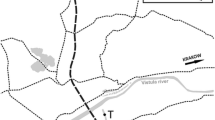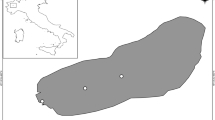Abstract
We conducted three exploratory experiments of factorial design on the effects of mineral turbidity in 18 large (7 000 1) fiberglass tanks containing plankton communities derived from Lake Texoma (Oklahoma-Texas), a large reservoir often subject to turbid inflows. Replicate plankton communities developed for 30–45 d in response to 4–9 treatments of planktivorous fish, dead fish, nutrient additions and artificial removal of zooplankton with plankton netting (or combinations of these manipulations). In one experiment we then added three concentrations of kaolin and in the other two experiments we added bentonite or powdered silica to the replicate tank communities. We measured the responses of the diverse plankton communities to the addition of mineral turbidity for an additional period of 30–45 d.
Effects of introduced minerals (quality or concentration effects) and food web treatments after mineral addition (fish, nutrients, etc.) were determined by analysis of covariance after observations were adjusted for the value of each response variable at the time of mineral addition. Covariance analysis resulted in a statistical model explaining > 80% of the variance for most response variables. The values of response variables at the time of mineral addition were often the most important source of variation, suggesting the importance of biotic community resiliency to the effects of mineral turbidity. There were few effects of mineral particles on physical or chemical (temperature, conductivity, oxygen, pH), nutrient (nitrate, phosphate, alkalinity) or biotic (algal or zooplankton populations) components of the tank communities. Mineral effects were found for several measures of water clarity (Secchi depth, turbidity, and the concentration of small sestonic particles).
Similar content being viewed by others
References
Arruda, J. A., G. R. Marzolf & R. T. Faulk, 1983. The role of suspended sediments in the nutrition of zooplankton in turbid reservoirs. Ecology 64: 1225–1235.
Avnimelech, Y., B. W. Troeger & L. W. Reed, 1982. Mutual flocculation of algae and clay: evidence and implications. Science 216: 63–65.
Avnimelech, Y. & J. R. McHenry, 1984. Enrichment of transported sediments with organic carbon, nutrients, and clay. Soil Sci. Am. 148: 259–266.
Brandorff, G.-O. & E. R. deAndrade, 1978. The relationship between the water level of the Amazon River and the fate of the zooplankton population in Lago Jacaretinga, a varzea lake in the central Amazon. Stud. Neotrop. Fauna Environ. 13: 63–70.
Dirnberger, J. M. & S. T Threlkeld, 1986. Advective effects of a reservoir flood on zooplankton abundance and dispersion. Freshwat. Biol. 16: 387–396.
Drenner, R. W., S. T. Threlkeld & M. D. McCracken, 1986. Experimental analysis of the direct and indirect effects of an omnivorous filter-feeding clupeid on plankton community structure. Can. J. Fish. Aquat. Sci. 43: 1935–1945.
Filardo, M. J. & W. M. Dunstan, 1985. Hydrodynamic control of phytoplankton in low salinity waters of the James River Estuary, Virginia, U.S.A. Estuar. Coast. Shelf Sci. 21: 653–667.
Fisher, R. A., 1949. The design of experiments (5th ed.). Oliver and Boyd. Edinburgh.
Gliwicz, M. Z., 1986. Suspended clay concentration controlled by filter-feeding zooplankton in a tropical reservoir. Nature 323: 330–332.
Grobbelaar, J. U., 1983. Availability to algae of N and P adsorbed on suspended solids in turbid waters of the Amazon River. Arch. Hydrobiol. 96: 302–316.
Hart, R. C., 1986a. Aspects of the feeding ecology of turbid water zooplankton. In situ studies of community filtration rates in silt-laden Lake le Roux, Orange River, South Africa. J. Plankton Res. 8: 401–426.
Hart, R. C., 1986b. Zooplankton abundance, community structure and dynamics in relation to inorganic turbidity, and their implications for a potential fishery in subtropical Lake le Roux, South Africa. Freshwat. Biol. 16: 351–371.
McCabe, G. D. & W. J. O'Brien, 1983. The effects of suspended silt on feeding and reproduction of Daphnia pulex. Amer. Midl. Nat. 110: 324–337.
Paggi, J. C. & S. J. Paggi, 1974. Primeros estudios sobre el zooplancton de las aguas loticas del Parana Medio. Physis (B) 33: 91–114.
SAS Institute, Inc., 1986. SAS for Linear Models. A guide to the ANOVA and GLM procedures. Cary, NC. 231 pp.
Shoaf, W. T. & B. W. Lium, 1976. Improved extraction of chlorophyll a and b from algae using dimethyl sulfoxide. Limnol. Oceanogr. 21: 926–928.
Søballe, D. M. & R. W. Bachmann, 1984. Influence of reservoir transit on riverine algal transport and abundance. Can. J. Fish. Aquat. Sci. 41: 1803–1813.
Søballe, D. M. & S. T. Threlkeld, 1985. Advection, phytoplankton biomass, and nutrient transformations in a rapidly flushed impoundment. Arch. Hydrobiol. 105: 187–203.
Søballe, D. M. & S. T. Threlkeld, 1987. Algal-clay flocculation in turbid waters: variations due to algal and mineral differences. Verh. Internat. Verein. Limnol. 23: Submitted.
Speziale, B. J., S. P. Schreiner, P. A. Giammatteo & J. E. Schindler, 1984. Comparison of N, N-dimethyl formamide, dimethyl sulfoxide, and acetone for extraction of phytoplankton chlorophyll. Can. J. Fish. Aquat. Sci. 41: 1519–1522.
Stabel, H. & M. Geiger, 1985. Phosphorus adsorption to riverine suspended matter. Implications for the P-budget of Lake Constance. Water Res. 19: 1347–1352.
Threlkeld, S. T., 1982. Water renewal effects on reservoir zooplankton communities. Can. Water Res. J. 7: 151–167.
Threlkeld, S. T., 1986. Life table responses and population dynamics of four cladoceran zooplankton during a reservoir flood. J. Plankton Res. 8: 639–647.
Threlkeld, S. T, 1987. Experimental evaluation of trophiccascade and nutrient-mediated effects of planktivorous fish on plankton cummunity structure. In W. C. Kerfoot & A. Sih (eds.). Predation: Direct and indirect impacts on aquatic communities. New England Univ. Press. pp. 161–173.
Threlkeld, S. T. & E. Choinski, 1986. Plankton in a rapidly flushed impoundment: spatial distribution, population dynamics and community structure. Mem. Ist. Ital. Idrobiol. 43: 105–118.
Threlkeld, S. T. & J. M. Dirnberger, 1986. Benthic distributions of planktonic copepods, especially Mesocyclops edax. Syllogeus 58: 481–486.
Vincent, W. F., 1981. Photosynthetic capacity measured by DCMU-induced chlorophyll fluorescence in an oligotrophic lake. Freshwat. Biol. 11: 61–78.
Vinyard, G. L. & W. J. O'Brien, 1976. Effects of light and turbidity on the reactive distance of bluegill (Lepomis macrochirus). J. Fish. Res. Bd. Can. 33: 2845–2849.
Author information
Authors and Affiliations
Rights and permissions
About this article
Cite this article
Threlkeld, S.T., Søballe, D.M. Effects of mineral turbidity on freshwater plankton communities: Three exploratory tank experiments of factorial design. Hydrobiologia 159, 223–236 (1988). https://doi.org/10.1007/BF00008236
Issue Date:
DOI: https://doi.org/10.1007/BF00008236




